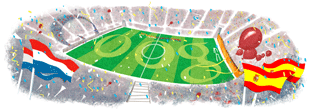Doodle History
Over the years, doodles on the Google homepage have made searching on Google more fun and enjoyable for its users worldwide. When doodles were first created, nobody had anticipated how popular and integral they would become to the Google search experience. Nowadays, many users excitedly anticipate the release of each new doodle and some even collect them!
Doodles are known as the decorative changes that are made to the Google logo to celebrate holidays, anniversaries, and the lives of famous artists and scientists. Whether it is the beginning of Spring,Albert Einstein's birthday, or the 50th anniversary of understanding DNA, the doodle team never fails to find artistic ways to celebrate these unique events.
Having a little bit of fun with the corporate logo by redesigning it from time to time is unheard of at many companies but at Google, it is a part of the brand. While the doodle is primarily a fun way for the company to recognize events and notable people, it also illustrates the creative and innovative personality of the company itself.
How did the idea for doodles originate?
In 1999, the concept of the doodle was born when Google founders Larry and Sergey played with the corporate logo to indicate their attendance at theBurning Man festival in the Nevada desert. A stick figure drawing was placed behind the 2nd o in the word, Google and the revised logo was intended as a comical message to Google users that the founders were “out of office.” While the first doodle was relatively simple, the idea of decorating the company logo to celebrate notable events was well received by our users.
A year later in 2000, Larry and Sergey asked current webmaster Dennis Hwang, an intern at the time, to produce a doodle for Bastille Day. Pleased with the result, Dennis was then appointed Google’s chief doodler and doodles became a regular occurrence on the Google homepage. In the beginning, the doodles tended to celebrate largely visible holidays; nowadays, doodles represent a wide array of events and anniversaries from the Olympics to the Mars Rover landing.
Over time, the demand for doodles quickly rose both in the U.S. and internationally. Creating doodles is now the responsibility of a team of talented designers. For them, creating doodles has become a team effort to enliven the Google homepage and bring smiles to a myriad of Google users worldwide.
For google doodle from 2001 http://www.google.com/logos/index.
